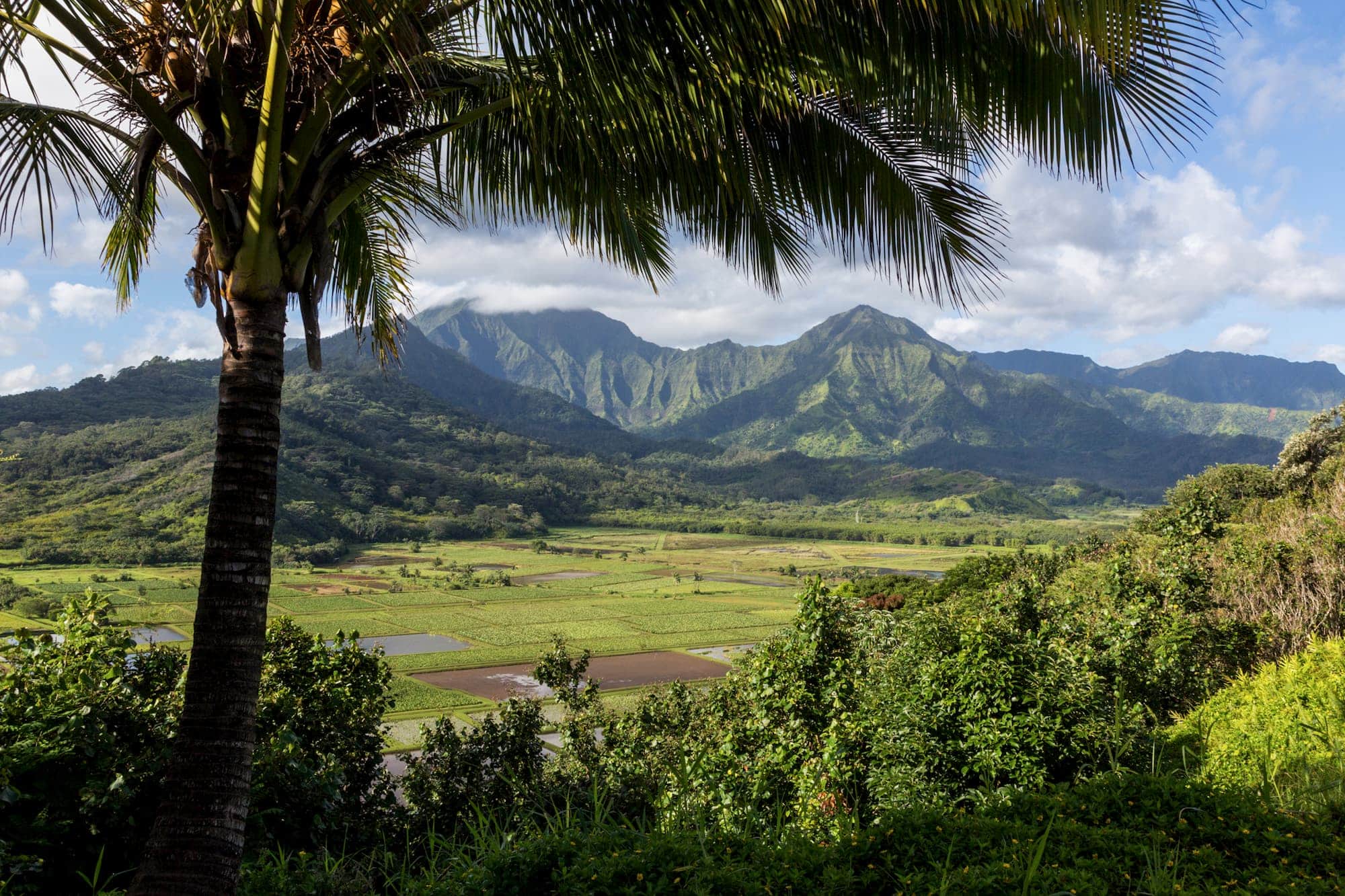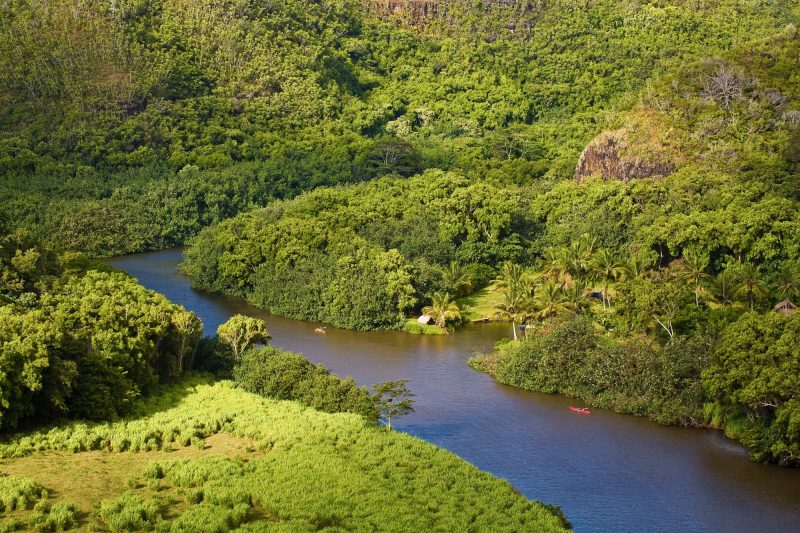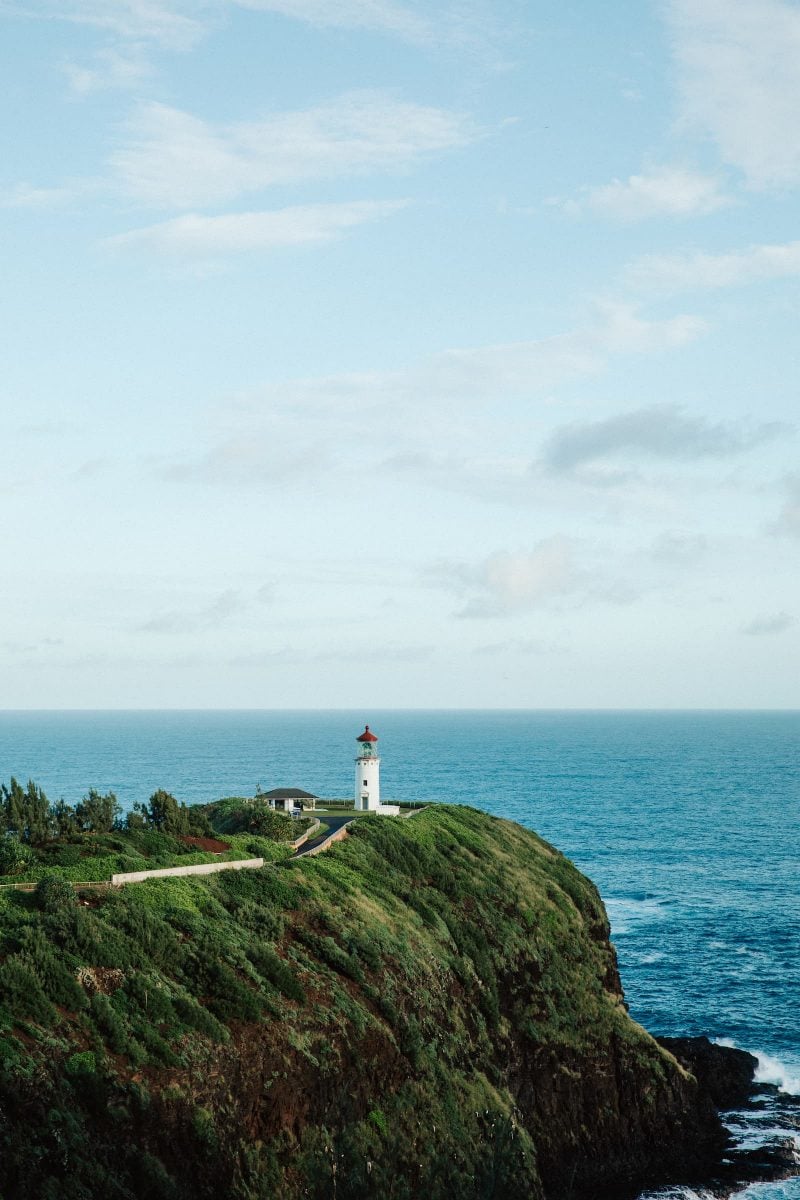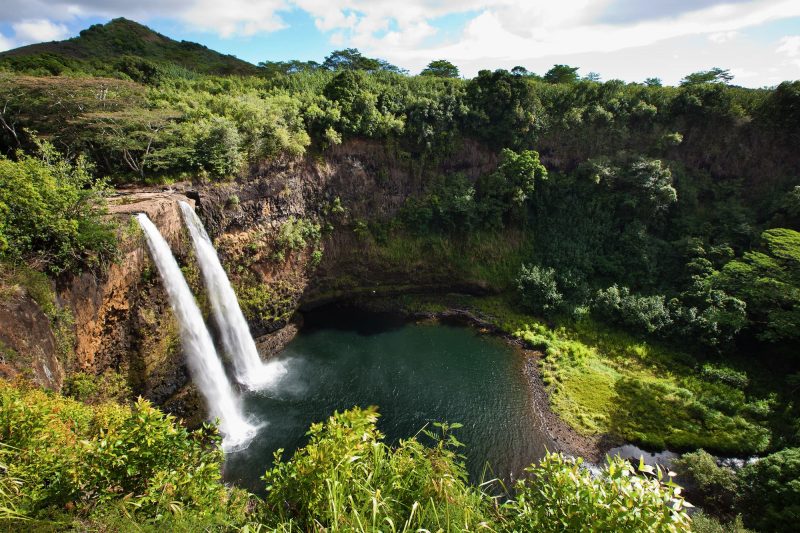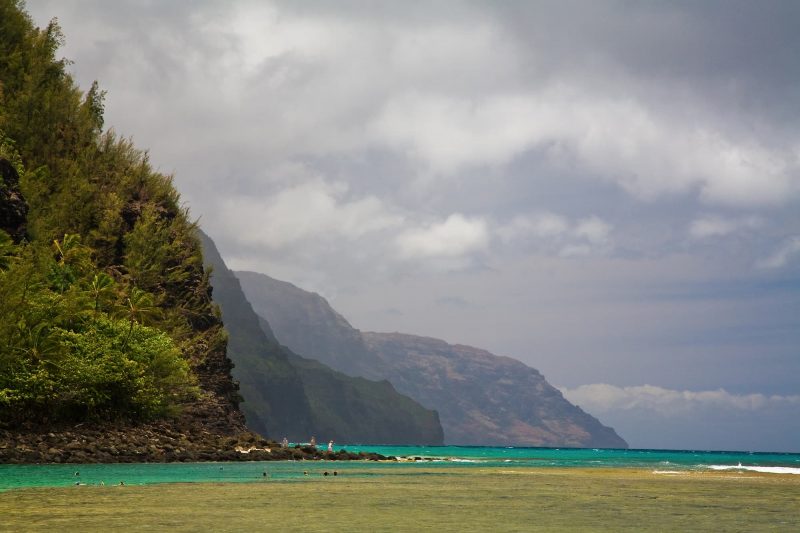Traveling to Kauaʻi for the first time? If so, this guide will help you understand the major sights and destinations to see around the island. The list below breaks down the most popular regions, points of interest, and attractions by category to give you the lay of the land and help you find your way around.
Most of the places in our list are quite popular, and while crowds are not ideal, sometimes it’s worth investigating to see what the fuss is all about. In many cases, the hustle and bustle of popular places can be avoided by visiting during off-peak hours, or by experiencing it in a slightly different way. We include this information below, where appropriate.
Most visited (regions)
These are highlights of the main regions and destinations of Kauaʻi. Get to know them first, as you will most likely make camp in one of them. See also our overview of Kauaʻi for a more in-depth description oft he Kauaʻi regions and highlights, and our 7 day itinerary for Kauaʻi for an example on how to divide your time between the regions.
Hanalei/Princeville
Hanalei is the main hub of Kauaʻi’s north shore. Featuring a long, horseshoe-shaped bay, white sand, and a mountain and waterfall-laden backdrop, Hanalei offers a relaxed, small-town coastal vibe in an otherwise green, agricultural region. While Hanalei has mostly vacation rentals to offer, the adjacent town of Princeville is where you’ll find a wide range of lodging options, including resorts, luxury condos, and golf courses amongst well-appointed and spacious landscaping.
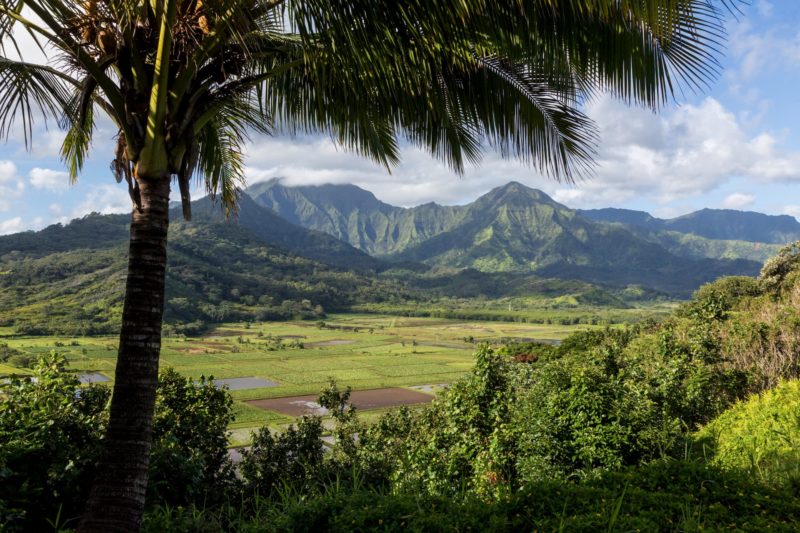
Traditional Hawaiian Taro fields stretch out in the lush valleys inland of Hanalei. Image credit: Hawaii Tourism Authority (HTA) / Tor Johnson
Generally speaking, Hanalei and Princeville are the gateways to the Nāpali Coast, offering reasonably quick access to the beach parks and hiking trails of the north shore. Hanalei Bay is a good spot for beginner surfers, and there are a variety of shops and restaurants in the town. The weather here can be more variable, especially during the winter rainy season.
Poʻipū
Poʻipū’s location on the dry south shore means it receives steady sunny weather, and its beaches are typically calm and swimmable. As a result, Poʻipū has become the main resort area of Kauaʻi, with the most to offer visitors in terms of selection and services. It is the most densely-developed area of the island, but that’s not necessarily a bad thing for families and others that appreciate conveniences.
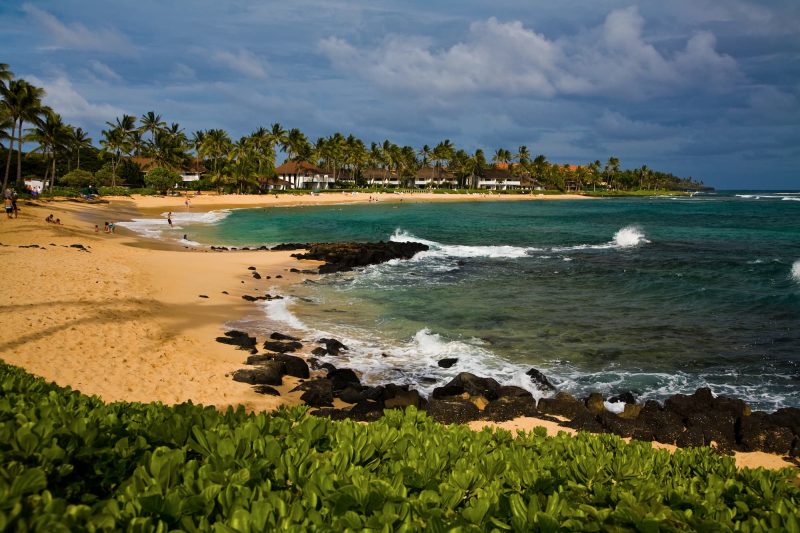
Poipu is a popular beach with a shallow, protected swimming area, snorkel & surfboard rentals & a playground. Image: Hawaii Tourism Authority (HTA) / Tor Johnson
There is a lot to do in and around Poʻipū. There are a number of good beaches to check out, as well as coastal hikes (Maha’ulepu Heritage Trail), cultural sites (Makauwahi Cave, Kāneiʻolouma Heiau), a variety of restaurants, golf courses, and the historic plantation town of Kōloa.
Līhuʻe
The capital of Kauaʻi, Līhuʻe is the central town of the island and the location of the airport. In this sense, everyone who visits the island passes through it at some time. It does offer a few hotel options near Nāwiliwili Harbor (like the Kauaʻi Inn and a couple Marriott properties), but it doesn’t offer the same quantity of beaches that you’d find in areas like Poʻipū, Hanalei/Princeville, and Kapaʻa.
That said, if you plan to do lots of exploring around the island, Līhuʻe makes for a great home base with easy access to and from the airport and a central location. In the town itself is where you will find a mix of great local restaurants as well as underrated points of interest, like the Kauaʻi Museum.
Kapaʻa
Formerly a plantation town, Kapaʻa has evolved into a small beach community on Kauaʻi’s eastern shore. Generally, its coast tends to be rough, but there are a handful of swimmable, family-friendly beaches within easy reach, such as Lydgate Beach Park or Kealia. Like Līhuʻe, its central location makes it a good hub for people who plan to be coming and going most days. Though swimming is not always possible, Kapaʻa boasts a wonderful beach path that connects its beaches, perfect for biking, walking, or exercising.
If you consider yourself a foodie, Kapaʻa will interest you greatly, as it has become the hub for food trucks on the island, as well as more modern culinary establishments, like Street Burger.
Kid-friendly
If you’re traveling with kids, these places and activities will be a big hit.
Lydgate Beach Park
Lydgate Beach Park is an excellent beach for families with children who like to play in the water. The beach is protected by stone walls that break the incoming waves, forming pond-like pools that are safe for young or inexperienced swimmers. Its calm waters are a good place to introduce children to snorkeling – there isn’t any sharp coral and a variety of tropical fish can be found.
Families should plan to spend a half or full day at Lydgate. Pack snacks, drinks, or meals in a cooler. You can find more information on Lydgate and other beaches in our guide to Kauaʻi’s beaches.
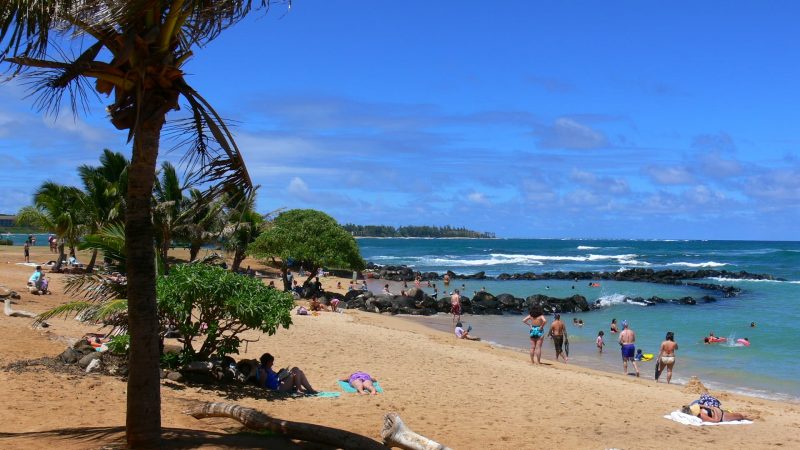
Lydgate is a fun, family-oriented beach with a lifeguard tower overlooking boulder-enclosed pools. Image credit: Jim Mullhaupt, source.
Kilohana Plantation Train
Kids and adults alike will love the Kilohana Plantation Train experience that introduces Hawaiʻi’s plantation lifestyle and ambiance to visitors. The train cruises through a variety of agriculture land, including a fruit tree orchard and tropical gardens, as well as animal pastures, where kids have the chance to feed pigs, goats, and sheep.
Tours depart multiple times a day, Monday through Saturday (closed Sunday). An on-board conductor will narrate the experience, explaining the different types of plants and trees as well as the past and present of Kauaʻi’s plantation days.
Horseback Riding
Kauaʻi’s combination of volcanic terrain and open pastures makes it a wonderful place to try out horseback riding. Specifically, the horseback riding experience at CJM Country Stables runs tours on the beaches of the South Shore near Poʻipū. You should definately check them out of you dream about horseback riding on the beach.
Outdoors
Kauaʻi is perhaps best known for its natural beauty. As the oldest island in the modern-day chain, its mountains have been beautifully eroded, and its land is lush and green. Here are the top outdoor sites to see.
Nāpali Coast
The Nāpali Coast, located on Kauaʻi’s north shore, is considered one of the most dramatic displays of beauty in all of Hawaiʻi. Its jagged peaks were shaped by millions of years of erosion, with deep grooves and countless waterfalls.
Hiking, boat trips, kayaking, beach parks, and helicopter fly overs are all ways you can experience the coastline, and we recommend trying out at least two or three of them.
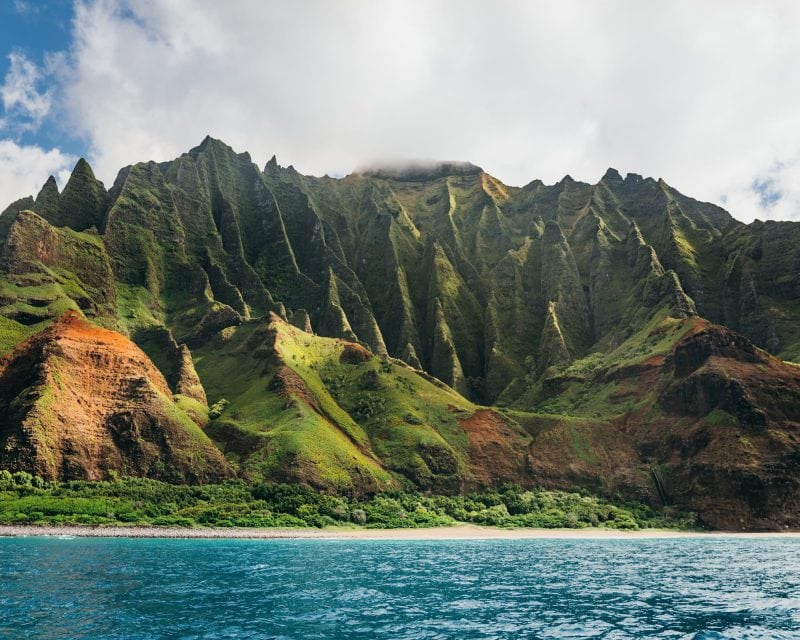
The Nāpali coast seen from the water is one of the iconic images Kauaʻi is famous for. Credit: Hawaii Tourism Authority (HTA) / Vincent Lim
For more information and tips, see our guide to the Nāpali Coast.
Waimea Canyon
Located at 3,500 feet above sea level, Waimea Canyon is about 14 miles long, a mile wide, and more than 3,600 feet deep. Indeed, it’s one of the most surprising natural areas found in all of Hawaiʻi, earning it the moniker of “the Grand Canyon of the Pacific.”
Waimea Canyon State Park offers hikes, a variety of lookouts (see below), and natural areas to explore, as does the adjacent Kōkeʻe State Park. Whether it’s just for a scenic drive or an all-day hike, Waimea Canyon is an absolute must when on Kauaʻi.
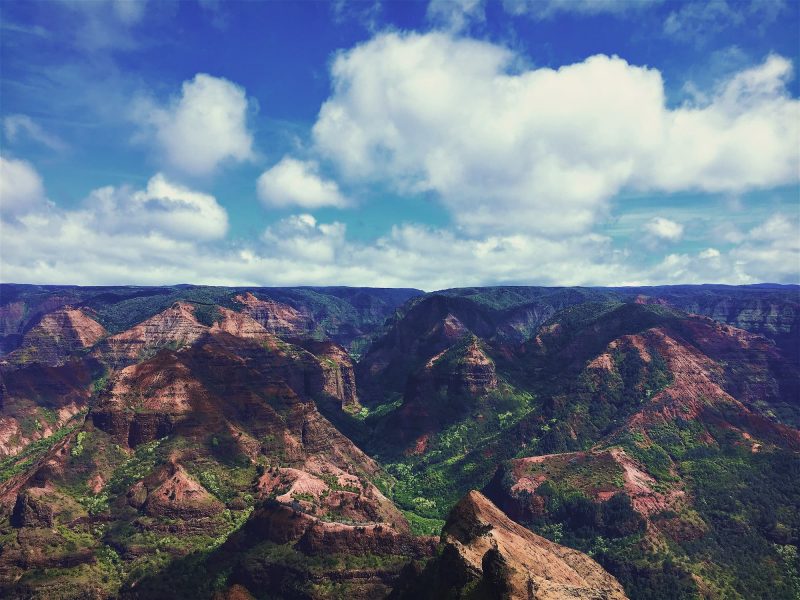
Waimea Canyon State Park is also know as the known as the “Grand Canyon of the Pacific” for obvious reasons. Image credit: Trogers on Flickr.
For more information and tips, see our dedicated guide to Waimea Canyon.
Wailua River State Park
Hawaiʻi is full of streams and small rivers, but there’s not many that are actually navigable. In this sense, Wailua River State Park offers visitors a unique opportunity to kayak inland on a large, flowing body of fresh water. You can rent a kayak from one of the vendors at the mouth of the river, and there are guided tours as well.
Wailua River State Park is home to a couple waterfalls, including Wailua Falls (inside the Park) and Opaekaʻa Falls (just adjacent). Other points of interest in the Park are Fern Grotto, the Kamokila Hawaiian Village, and the Smith Family Garden Lūʻau.
Hawaiian History, Art, & Culture
If you’re looking for historical and cultural perspective or artistic color, check out these destinations. For more, see the compilation of our favorite cultural and historical sites on Kauaʻi.
Kauaʻi Museum
Kauaʻi was the first Hawaiian Island visited by Captain Cook, and it’s also the oldest inhibited island in the modern-day chain. Needless to say, it carries with it a lot of history, both before and after the arrival of westerners.
The Kauaʻi Museum in Līhuʻe introduces visitors to the royal families that once ruled Kauaʻi, as well as the natural history of the island and its people. Small and quaint, the museum can be experienced in an hour or two and is a nice, perspective-adding stop to make in the first few days of your trip.
Hanapepe Friday Night Art Walk
The south shore is home to Kauaʻi’s art scene, and you’ll find the highest concentration of local galleries on display in the small town of Hanapepe. For the full experience, check out the Friday Night Art Walk between 6 p.m. – 9 p.m., which has been occurring weekly since 1997.
During the Art Walk, the main street is filled with artistic displays, live music, and food vendors – a nice opportunity to check out the town, take in the art, and perhaps even walk across the town’s infamous swinging bridge.
Grove Farm Museum
Kauaʻi’s history is deeply entrenched in sugar cane and its plantation roots. In fact, the sugar cane era was one of the most influential periods in Hawaiian history, bringing in workers from across the world, from Europe to Asia. Indeed, it is the reason that Hawaiʻi, a small island chain in the middle of the Pacific Ocean, has a wide-reaching population whose diversity rivals that of major cities on the mainland.
If you want to learn more about the plantation days on Kauaʻi, check out the Grove Farm Museum. Set on a one hundred acre homestead, visitors can experience what life on the plantation was like and learn more about its economic and social impacts on the islands.
Scenic and Photogenic Spots
As with all the Hawaiian Islands, scenic spots are not hard to come by – wherever you are, there it is. That said, whether you’re an amateur photographer or simply looking for a good backdrop for a family photo, these are some of our favorite scenic areas of Kauaʻi.
Overlooks at Waimea Canyon
Waimea Canyon offers an abundance of outdoor adventure, including a range of hiking trails, pull offs, and easily-accessible lookouts. If you’re looking for a place to snap some photos, either of the natural scenery itself or family photos with a beautiful background, you can’t go wrong at Waimea Canyon. As the canyon is comprised mostly of red rock, it’s best to go in the early morning or late afternoon for the best lighting.
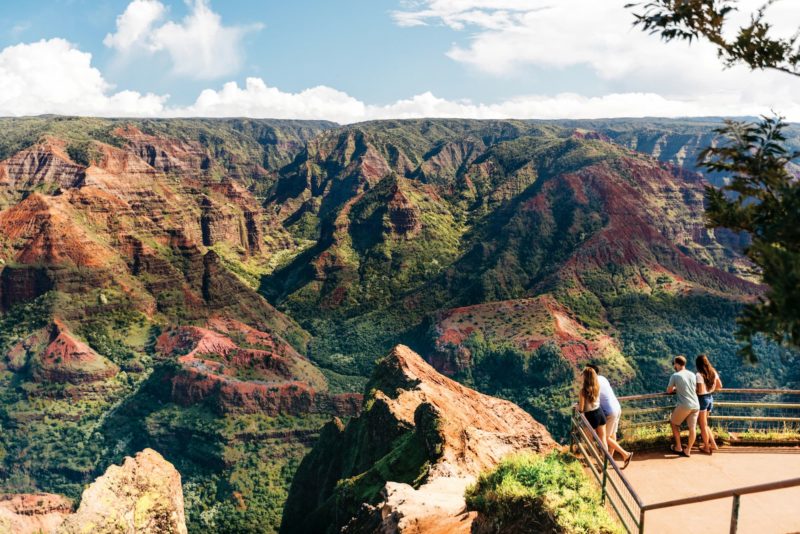
The easily accessible Waimea Canyon Lookout gives amazing views of Waimea Canyon. Image credit: Hawaii Tourism Authority (HTA) / Ben Ono
Kīlauea Lighthouse
The Kīlauea Point National Wildlife Refuge and Lighthouse is a natural scenic area and protected seabird sanctuary. It features a large peninsula, upon which the lighthouse sits, that’s surrounded by tall sea cliffs, crashing waves, and panoramic ocean views. There are marvelous opportunities here for photos of wildlife (mainly seabirds), cliffs, the lighthouse, the ocean, and the coastline.
Wailua Falls
This easy-to-access waterfall in Wailua River State Park can get crowded, so in that sense, you must bring your patience. But arrive early in the morning or late in the afternoon, and you’ll be able to get great shots of the waterfall, which serves as a wonderful background for family photos.
Keʻe Beach
The gateway to the undeveloped Nāpali Coast, Keʻe Beach is the last beach park before the coastline turns into a hiking trail. From here, you have a great perspective and vantage point on the mountainous coast, which makes a great backdrop for photos. The combination of the ocean, the beach, and the mountains here will delight photographers, and we suggesting making an evening of it during the sunset.
Hidden Gems
You won’t have any trouble finding these places, but they remain “hidden” in the sense that they are located a bit out of the way.
Polihale State Park
Polihale State Park is located way out on the west coast of Kauaʻi, basically where the road ends. It is an undeveloped, large sandy beach that boasts views of the western edge of the Nāpali Coast – a vantage point most visitors don’t see or appreciate.
Because it is so far out of the way – about an hour from Poʻipū – it is usually not crowded, and you can even camp there for the night with a permit. Note: Car rental companies often have restrictions against driving the dirt access road, so check with them. Alternatively, you can park outside the entrance and hike into the beach.
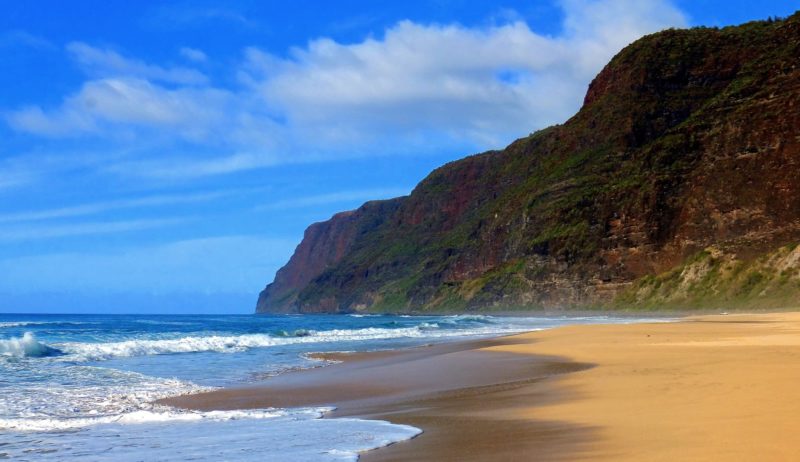
Polihale State Park is a remote wild beach and a great choice for those people seeking isolation. Image credit: K E V I N, source.
Niʻhau
This hidden gem is so “hidden” that it’s not even on the same island! Located off the southwest coast of Kauaʻi, the island of Niʻihau is generally off limits to visitors. However, there are tours that allow you to visit close to its shores and even snorkel off its coast. See for example the following one:
Niʻihau + Nāpali Coast 7 hour long Super Tour
EXCELLENT value 7-hour Napali Coast tour to Niihau with snorkeling, breakfast, lunch, and drinks included.
from:
$310
What is a suggested tour?Our suggested tours are hand-picked tours that receive consistent good reviews, give back to the community, and work hard to minimize their impact on the environment. Read more about these tours on our website.The chance to get close to Niʻihau is a unique one, indeed, something that very, very few people get to experience. We recommend looking into it during your visit to Kauaʻi.
Lists of best places to see on the other islands
Are you also visiting other islands?
If so, then we recommend to have a look at our other “favorite sights and destinations” guides for Maui, Oʻahu, and the Big Island. These guides use the same format as this one (a few favorites in each of the following categories: most visited, kid-friendly, hidden gems, most instagrammable/scenic, outdoors, and history & culture) and are a great introduction to where to go on those islands.
